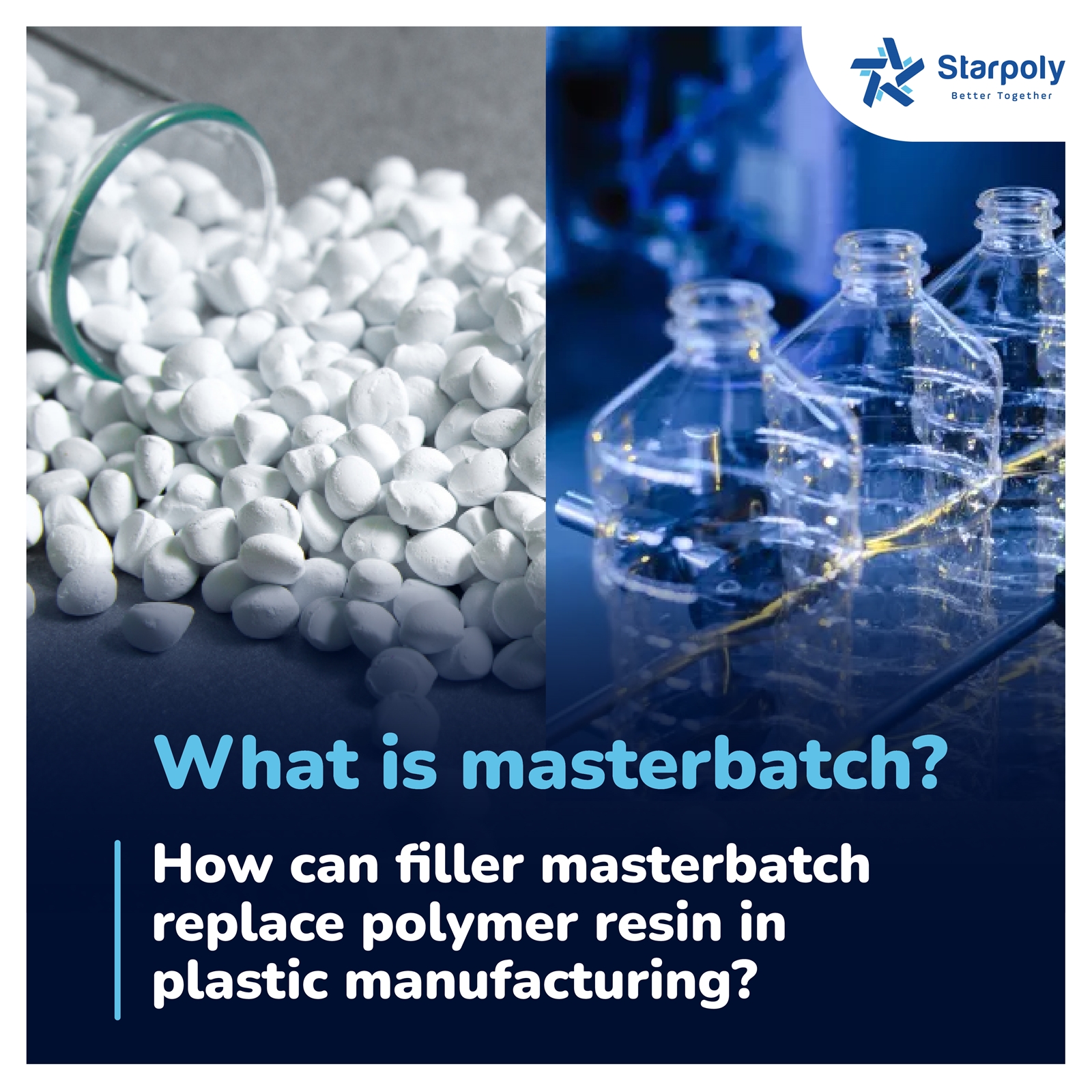Calcium carbonate filler, also known as calcium carbonate masterbatch, stands as a core product in the StarPoly portfolio. It has consistently maintained its popularity within the plastic industry, enduring the advancements in processing and modification technologies that have evolved over the years. What attributes of calcium carbonate filler have led to its enduring popularity among manufacturers? In this post, we'll delve into the key characteristics that make it a widely embraced choice
1. What is masterbatch?
Masterbatch, or plastic masterbatch, is concentrated plastic pellets consisting of carrier resin, plastic fillers, colorant for plastic, and other additives. The word “masterbatch” means the main mixture.
Masterbatch finds application in plastic production primarily for three key objectives:
- Minimizing the necessary resin quantity
- Adding color to plastic items
- Improving the functional characteristics of plastic products
According to these functions, masterbatches are categorized into three primary groups: color masterbatch, additive masterbatch, and filler masterbatch.

2. How can CaCO3 Filler masterbatch replace polymer resin in plastic manufacturing?
✅Cost Reduction: One of the primary reasons for using CaCO3 filler masterbatch is to reduce the cost of plastic production. Calcium carbonate is relatively inexpensive compared to polymer resins. By incorporating filler masterbatch into the formulation, you can reduce the amount of expensive polymer resin needed, resulting in cost savings.
✅Density Reduction: CaCO3 filler masterbatch can reduce the density of plastic products. This is particularly beneficial in applications where lightweight materials are desired. The addition of calcium carbonate increases the volume of the product, which can lead to weight reduction.
✅Improved Mechanical Properties: Depending on the specific application and formulation, the addition of CaCO3 filler masterbatch can enhance certain mechanical properties of the plastic, such as stiffness, impact resistance, and dimensional stability.
✅Environmental Benefits: Using filler masterbatch can be more environmentally friendly, as it reduces the consumption of polymer resins, which are derived from petrochemical sources. This can help reduce the environmental footprint of plastic products.
✅Improved Processing: CaCO3 filler masterbatch can improve the processing characteristics of the plastic, making it easier to extrude, mold, or otherwise shape the material. This can result in more efficient and cost-effective manufacturing processes.
✅Cost-Efficient Coloring: CaCO3 filler masterbatch can also be used as a carrier for color pigments. This simplifies the coloring process in plastic manufacturing, reducing the need for additional color additives.
It's important to note that CaCO3 filler masterbatch is typically not used as a complete replacement for polymer resin, as it doesn't provide the structural integrity and other essential properties that the resin contributes. Instead, it is used as a supplement to achieve specific performance and cost objectives.
The exact formulation and application of CaCO3 filler masterbatch will vary depending on the type of plastic, the desired properties, and the intended use of the final product. Manufacturers need to carefully balance the amount of filler with the polymer resin to ensure the product meets the required specifications.
3. What are the properties of calcium carbonate filler?
The properties of calcium carbonate filler, a core product offered by StarPoly, are worth exploring. This natural compound, CaCO3, can be found in geological mines and the biological structures of living organisms, particularly in eggshells, marine organism shells (like oysters, sea shells, snail shells, and corals). However, the primary source of calcium carbonate filler is limestone quarries. In its natural state, CaCO3 exists in three main crystal forms: calcite, aragonite, and vaterite. Among these, calcite, due to its crystal structure, is the most commonly used variety in commercial applications.
Calcium carbonate is typically a white, odorless, fine powder with a melting temperature range of 800 to 1400°C. Its molecular weight is 100.087 g/mol.
The chemical properties of calcium carbonate (CaCO3) are key to its widespread use in plastic production. When mixed with various types of plastics and additives, its chemical properties remain unchanged. Additionally, calcium carbonate is insoluble in water, stable at normal temperatures, and only reacts with certain strong, medium, or weak acids. This stability and lack of reactivity make it suitable for a wide range of applications, including those involving user safety, such as the food and beverage industry.
There are two common types of calcium carbonate used in industries: coated CaCO3 and uncoated CaCO3. Coated CaCO3 is sourced from high-purity limestone or white marble mines and is coated with fatty acids (stearic acid) and a bonding agent (Titanate Coupling Agent) on its surface. The physical and chemical properties of these two types of calcium carbonate masterbatch are generally similar, with the only significant difference being in oil absorption, where uncoated CaCO3 is superior. Key physical properties include whiteness (98% minimum), brightness (96% minimum), humidity (0.2% maximum), gravity (2.7 g/cm3), and specific surface area (4.23 - 4.72 m2/g). The chemical composition of both types includes calcium carbonate (CaCO3, 98.5%), silicon oxide (SiO2, 0.03%), magnesium oxide (MgO, 0.02%), aluminum oxide (Al2O3, 0.02%), and iron oxide (Fe2O3, 0.02%).
4. Which plastic product can use CaCO3 Filler Masterbatch?
In the plastics industry, calcium carbonate filler is used in combination with a wide variety of plastics, including rigid and flexible plastics and thermoplastics. Its applications are diverse and can be observed in everyday items such as food wraps, shopping bags, and garbage bags, produced through injection molding, PP and PE Injection Mold Products, Blow-Mold Products, Nonwoven Fabrics, Woven Fabrics